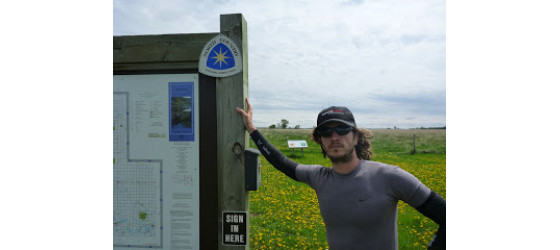
Guest blog: Doing more with less (part 4), going mental! by Andy Magness
Posted In: Coaching | Goals | Running February 22nd, 2013 divider No Comments »The longer the race, the more the required elements for success shifts towards the mental side of the mental-physical continuum. In the case of a 4 hour event there might still be a pretty even balance. By the time you reach the 24 hour level though, the truth of the matter is that even a super fit athlete is going to go through at least one period where physically they feel absolutely awful. What this means is that no matter how fit you might be going in, if you don’t have the mental toughness to push through this low point you won’t finish.
The good news is that if you’re an enduro-phile who’s got this mental toughness then you can probably get away with a low-volume, high intensity workout program and enjoy a reasonable level of success in some events that are considered to be monstrous efforts. The bad news, or maybe the fine print rather, is that this comes with a few caveats:
1) Experience helps. Although I have met a few people (and thereby believe in their existence) that haven’t really done anything endurance oriented but do seem to have somehow developed – or were just born with – the required mental toughness, most people without experience simply don’t have it. It might be a good thing, however, because while HIIT might provide one with a physical platform for ultra endurance muscularly and cardiovascularly speaking, research suggests that connective tissues (tendons, ligaments, etc) take a bit longer to develop the ability to deal with the high repetitions demanded of such events. In my opinion, if one is planning to use low volume, HIIT to attack ultra endurance racing, putting in a years worth of progressively longer events during the start of one’s budding endurance ‘career’ will help prevent injury to these connective tissues.
2) 90% Mental still means 10% Physical. Even when the balance places heavy burdens on the mental, the physical still plays a pretty important role. For instance, the fitter you are, the further you will tend to get before coming face to face with the wall of doubt and discomfort that is the inevitable result of a long enough race. This matters because – to keep it simple – the difficulty associated with overcoming this doubt is pretty much proportional to the ratio of race distance/time remaining to race distance/time completed. When you’re at your lowest point and considering a DNF (for whatever reason), if part of your internal dialogue includes a glimpse of how far you’ve come – and that distance is significant compared to how far you have yet to go – you’re much more likely to continue. For this reason, getting as fit as you can (with whatever training time to decide to use), is beneficial.
3) Sorry, not for sale. For those that don’t have it, mental toughness is hard to come by – irrespective of training volume. While true HIIT requires extraordinary focus and determination in the short term, it offers no exposure to the mental grit needed for real endurance success. Conventional (ie high volume) training, on the other hand, often attempts to provide some version of mental toughness by requiring big efforts as part of the program. In doing so, it fosters a bit of what I call ‘conventional confidence’ – a belief in one’s abilities and chance of success based on external validation measured against the prescribed training regimen. In other words – we feel ready because we have done X, Y, and Z as we were told (and in some cases we even paid to be told) and are now deemed ready according to an external source of conventional wisdom. This works sometimes, particularly at the lower end (shorter duration) of endurance racing. But my experience has been that as one pursues more daunting goals, ‘conventional confidence’ both fails and can even lower chances of success. Why? Because you can’t train to make a 24 hour race feel easy. Even 20 hour a week training programs won’t reproduce the mental and physical challenges that need to be overcome in such events and if (or rather when) that low point is hit, a crumbled sense of external confidence can create more doubt and reasons to quit for an athlete that initially had higher expectations of success. Ultimately, ‘internal confidence’ is critical for such efforts and unfortunately isn’t readily developed in budding enduro-philes by either HIIT or conventional higher volume training.
The last caveat begs the question of how to develop mental toughness. The good news is that, at least in my opinion, it is possible for most people. The bad news is that if you’re starting from near scratch it can take a pretty consistent commitment, will entail a fair bit of misery, and probably a little bit of (at least perceived) risk. So what’s the prescription? Trial by fire. But we’ll cover that, and provide a basic nuts and bolts guide to ultra endurance training “three hours a week style”, in the last installment of the series.
***
Andy Magness is a 37 year old amateur athlete and adventurer based in Grand Forks, North Dakota . He strives to find the balance between work, family, and an outrageous desire to be fit enough to ‘do anything’. His blog threehoursaweek.blogspot.com chronicles his attempt to ‘do more with less’.
